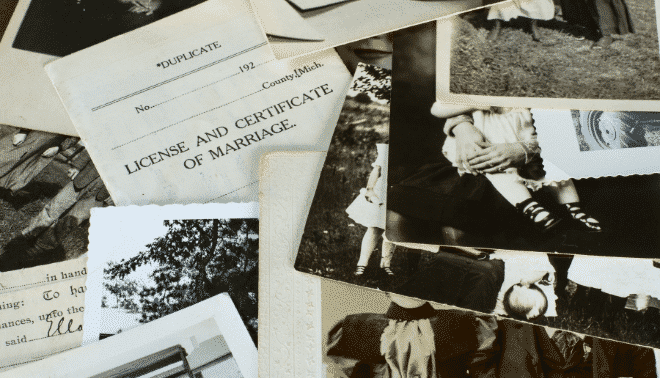Sign up for the Family Tree Newsletter! Plus, you’ll receive our 10 Essential Genealogy Research Forms PDF as a special thank you.
Get Your Free Genealogy Forms
"*" indicates required fields
Schedule time with family and prepare for the summer months ahead! These five projects will help you connect with relatives and safeguard your research.
1. Plan a Family Reunion or Get-Together
When was the last time you saw your extended family? The summer months are a classic time for families to come together to celebrate significant anniversaries or get some face-to-face time. Start planning reunions/outings this month, before summer calendars fill up.
Survey family members for a weekend that works for most of them. Memorial Day, the Fourth of July, and Labor Day are popular options, which is both beneficial and harmful—many people are off work, but lots of competing activities take place on those weekends.
ADVERTISEMENT
Next, decide on a venue and activities. Some other factors to keep in mind as you plan your reunion:
- Weather: Is your itinerary rainproof? If not, what is your rainy-weather plan? How will you handle heat and humidity?
- Accessibility: Do some family members who have mobility issues? Make sure your venue can accommodate them with (for example) ramps or elevators.
- Communication: How will you get the word out about the get-together? These tools can help.
- Budget: If possible, keep costs low for both you and attendees.
You’ll also want to prepare the relevant parts of your research for the get-together, if the gathering will have a genealogical element. You might, for example, print a large family tree that includes all attendees, or create reunion souvenirs inspired by family history.
2. Schedule Interviews with Family
Many genealogists first become interested in family history because of stories passed down from relatives. And (though you’ll want to verify them) oral histories can be important starting points for research, particularly for families whose ancestors were largely undocumented by records or for whom records have been lost.
ADVERTISEMENT
Smaller-scale visits or even virtual visits are also a nice alternative to large-scale reunions if such a big gathering is too much effort for you or your relative. This is especially true for relatives who are elderly, live far away from you, or have difficulty traveling outside their homes.
Before approaching your relative, decide on the scope of your questions. (We have suggestions here.) Plan to bring photos or printed copies of records and charts, which can spark memories. And don’t forget to record the conversation—with the interviewee’s consent, of course.
Remember: Time is of the essence when interviewing relatives and recording their stories. Unless properly documented, a person’s memories—including their knowledge of family history—die with them. (Talk to nearly any genealogist, and they’ll talk about a relative they regret not interviewing sooner.) Prioritize interviewing older or sickly relatives, and extend your interviewee pool to include aunts, uncles, cousins and even local historians.
Be respectful if your ancestor is reluctant to answer certain questions. Memories (especially those that were traumatic or involve those who are now deceased) can be painful to re-live, and not everyone will be comfortable discussing sensitive family topics.
3. Prepare for Travel
Whether for family reunions, visits to far-away relatives, destination vacations, or sight-seeing, travel is a summer highlight for many families.
Spend some time now gathering supplies and finalizing your itinerary. In addition to what you’ll need for research (printed charts, lists of records to consult, etc.), check for standard travel essentials: comfortable, weather-appropriate clothes and shoes; travel-size toiletries; passports and other ID; local currency; and so on. Consider finding activities for the non-genealogists in your party if you’re spending some time doing research.
4. Take a DNA Test—or Revisit Your Results
DNA Day on April 25 commemorates the publication of DNA’s double-helix structure in Nature journal. And it’s a great opportunity to take a DNA test or buy one for someone else, since many companies offer DNA Day discounts. (Not sure which company to test with? Shannon Combs-Bennett compares the five main autosomal DNA tests here.)
DNA Day is also a good excuse to review your DNA results, which may have changed since the last time you saw them. Check for any new matches, updated ethnicity estimates, and new tools that your testing company has made available. You might even consider uploading your results to another company or a third-party tool such as GEDmatch.
5. Weather-Proof Your Research
Floods, thunderstorms, hurricanes, earthquakes, lightning, forest fires—with warmer temperatures come a whole host of potential natural disasters. You can’t control these and all the “April showers” due this month, but you can take preventative measures to give your research the best chance of surviving calamities.
Evaluate where and how you’ve stored your family archive. Make sure your family photos, genealogy record, files, and heirlooms are stored:
- In a place with consistent, mild temperature and low humidity
- Away from direct sunlight, which can cause materials to fade over time
- In archival-safe folders and boxes
- Up high to avoid possible water damage, preferably in an interior closet
Avoid storage places prone to flooding and temperature changes, including garages and unfinished basements. You’ll also want to regularly check for any evidence of pests, from moths to mice to silverfish.
You can mitigate some risk by digitizing your research. The LOCKSS acronym (Lots of Copies Keep Stuff Safe) suggests having copies of digital files in multiple formats and on multiples devices. Another guideline is the “3-2-1” principle:
- Three distinct copies of files
- On two different storage media (e.g., an external hard drive and a web server)
- With one medium stored off-site (e.g., a hard drive in a bank’s lockbox or stored in the cloud)
Scanning technology and digital storage are much cheaper and more effective now than they were even 10 years ago, making the digitization process more accessible and intuitive.
Last updated, March 2024.
Related Reads
ADVERTISEMENT











